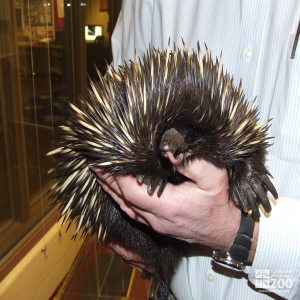Echidna, Short Beaked
[Tachyglossus aculeatus]

The short-beaked echidna has a head and body length of about 12 to 18 inches. They weigh between 5.5 to 17.6 pounds. Males are 25% larger then females.
The spiny coat provides an excellent defense. When suddenly disturbed on hard ground an echidna curls up into a spike covered ball. If disturbed on soft soil it may dig rapidly straight down, like a sinking ship, until all that can be seen are the spines of the well-protected back. Their sense of hearing is very good, and they can hear humans approaching and take cover long before they can be seen.
Food is located by sense of smell. Adult echidnas do not have teeth. The tongue is covered in sticky saliva that helps them capture insects.
Short-beaked Echidnas are solitary animals, inhabiting a home range which varies in size depending on the environment. A female incubating an egg or suckling young has a fixed burrow. Young echidnas are called ""puggles."" A puggle lives in its mother's pouch for about 3 months, then the mother digs a nursery in the ground. At 7 months the puggle is old enough to leave the nursery. An echidna lays eggs like a chicken, has a pouch like a kangaroo, spines like a porcupine, and slurps up insects with a long, flexible tongue like an anteater.
Location: Animals Formerly at Zoo
Share:
Range
The range of the short-beaked echidna is Australia, Tasmania, New Guinea
Habitat
Almost all types of terrain suit the short-beaked echidna, from semi-arid to alpine regions.
Conservation Status
Least ConcernPrimary Threats
Gestation
The incubation of eggs is about 10 days.
Litter
1
Behavior
Short-beaked Echidnas are solitary animals, inhabiting a home range which varies in size depending on the environment. In wet forest with abundant food the home range is about 124 acres. There is no fixed shelter site. Echidnas take shelter in hollow logs, under piles of rubble and brush and under thick clumps of vegetation. Sometimes they dig shallow burrows as long as 4 feet, which may be reused. A female incubating an egg or suckling young has a fixed burrow. The home ranges of several individuals overlap. Echidnas are usually active at dusk and dawn, but during the hot summer they are nocturnal, and during cold periods they may be diurnal. They avoid rain and will remain inactive if rain continues. Echidnas’ calls are similar to the cooing of a dove.
Reproduction
During the mating season (June – August on mainland Australia) the short-beaked echidna female leaves a scent track by everting the cloaca, the wall of which contains numerous glands. This attracts males in overlapping ranges. The only time Echidnas are observed in groups is during the mating season, and on the only occasion when the sex of individuals in such a group was determined, the group consisted of one female being followed by a line of five males. In the breeding season the female develops a crescentic fold of skin which forms a pocket on the abdomen. The single grape-sized egg is laid into the pouch by extension of the cloaca while the female lies on her back. After about 10 days the young one hatches, using an egg tooth. The single young remains in the pouch until the spines begin to erupt (after about 50 days). For a further six months or so it continues to suckle. They become fully independent and move out to find their own territory after about a year.
Wild Diet
Primarily ants and termites
